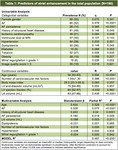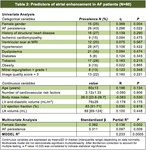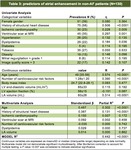Purpose
Atrial fibrillation (AF) is the most frequent cardiac arrhythmia and a leading cause of heart failure and stroke (1).
Myocardial fibrosis of the atrial wall is a constant feature in AF patients at histology (2).
Besides AF,
atrial fibrosisisalso related tomitral regurgitation,
ventricular dysfunction and ischemia.Delayed-enhanced (DE) MRI was shown to accurately depict focal areas of fibrosis in the ventricle (3).
Using free breathing DEMRI method,
authors have recently describeda contrast in the atrial wall,
and reported an association between the extent of DEand the...
Methods and Materials
Population. Consecutive patients referred for cardiac MRI were prospectively included,
the inclusion criterion beingindication for cardiac MRI according to current guidelines.
Exclusion criteria were any contraindications to MRI,
history of an acute cardiac event in the preceding 3 months and history of prior cardiac ablation or cardiac surgery.
Out of a total of 817 patients,
587 were excluded and 190 patients were finally included in the study.
Magnetic Resonance Imaging. MRI studies were conducted on a 1.5 T clinical system (Avanto,
Siemens Medical Solutions,
Erlangen,...
Results
Baseline Characteristics.Population characteristics are shown in Table1.
Out of the 190 patients (age 50 [40-63],
66 women) AF was present in 60 patients and structural heart disease (SHD)in 91.
Fifty-five patients had no history of AF nor SHD.
Predictors of DE.In the general population,age,
presence of AF and SHD were independently associated with DE (Table 1).In AF patients,
female gender and AF persistencewere independently associated with DE (Table 2).In non-AF patients,
age and presence of SHD were independently associated with DE (Table 3).
Examples of...
Conclusion
In the general cardiology population,
atrial DE on MRI is associated with age,
AF and SHD.
In patients with AF,
arrhythmia persistence and female gender are also associated with a higher burden of DE.
DEpredominates on the posterior wall of the left atrium.
References
Kannel WB,
Abbott RD,
Savage DD,
et al.
Epidemiologic features of chronic atrial fibrillation: the Framingham study.
N Engl J Med.
1982;306:1018–1022.
Burstein B,
Nattel S.
Atrial Fibrosis: Mechanisms and Clinical Relevance in Atrial Fibrillation.
J Am Coll Cardiol.
2008;51:802–809.
Kim RJ,
Wu E,
Rafael A,
et al.
The use of contrast-enhanced magnetic resonance imaging to identify reversible myocardial dysfunction.
N Engl J Med.
2000;343:1445–1453.
Oakes RS,
Badger TJ,
Kholmovski EG,
et al.
Detection and quantification of left atrial structural remodeling with delayed-enhancement magnetic resonance...






